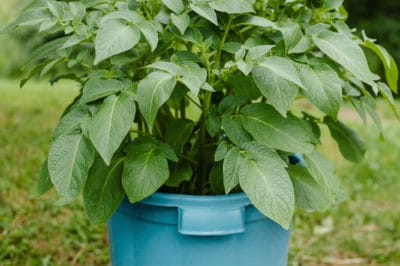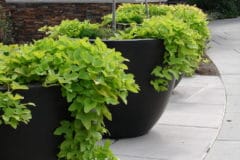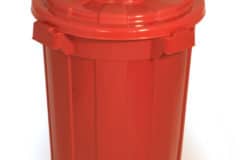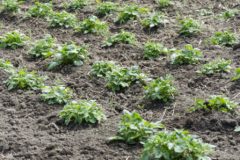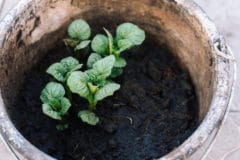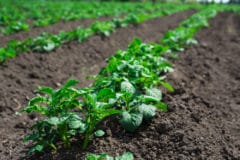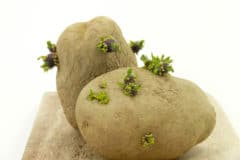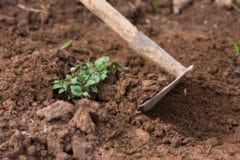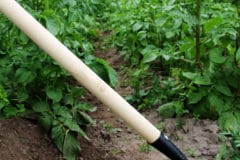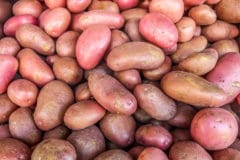Advantages of Containers
If you struggle with potato scab or other soil-borne diseases, containers can solve that problem. Containers also can make it easier to protect your spuds from pests that like to eat them, like mice and raccoons. A container can also prevent soil-borne insect pests like wireworms, flea beetles, potato tuberworm and white grubs. Growing container potatoes is also a great project for kids.
Disadvantages of Containers
A container filled with potatoes and soil can be very heavy, especially if the soil is wet. It can be more difficult to manage the water needs of potatoes in containers. Some containers – like grow bags – may increase the risk of evaporative water loss. Others, like plastic pots with small drainage holes, may not drain well, which encourages root rot.
Choosing Varieties for Containers
There are literally thousands of potato varieties available. Generally speaking, short-season varieties do best in containers. Fingerlings also adapt well to containers. Here are some possibilities:
- Belle de Fontenay
- French Fingerling
- Jersey Royal
- Maris Piper
- Nicola
- Ozette
- Pink Fir Apple
- Ratte.
Soil for Containers
Potatoes are not particularly fussy about soil as long as it drains well. Heavy clay, for example, can cause problems, especially in containers. Commercial potting soil is a good choice and decreases the risk of soil-borne disease. If you want to mix your own, add plenty of well-rotted organic compost, leaves or aged manure – do not use fresh manure. A pH between 5.0 and 5.5 decreases the risk of scab.
Watering Potato Containers
Potatoes like slightly moist soil but not constantly wet conditions. Your climate and the weather will affect watering needs – in dry areas of USDA Zone 9, for example, you may need to water daily in summer. Check to make sure the container is draining well – water should never stand around the roots. Decrease watering when tops start to die down.
Fertilizer for Containers
Potassium is one of the most important nutrients for healthy potatoes. Wood ash is a good way to add potassium, but it can also raise soil pH, so perform soil tests to check. Potatoes also have relatively high nitrogen needs. Mix cottonseed meal, bone meal, greensand and kelp for potato fertilizer. You can also use a commercial 10-10-10 NPK mix. Apply lightly and water in well.
Choosing Containers
You have plenty of options for containers. Commercial types include plastic or ceramic pots as well as grow bags. Some gardeners use 30-gallon trash containers. You can build or buy a potato tower made of fencing wire, chicken wire, wood, old wooden pallets or discarded tires. Remember that many of these will be heavy, so make sure you site them in the right place. Make sure the container has bottom drain holes.
Growing Space
One of the biggest mistakes gardeners make when growing potatoes in containers is not allowing enough space. Crowded conditions will result in excessively small potatoes or limit your total harvest. A single potato needs the equivalent of 2.5 gallons of growing space. If you allow one cubic foot (a square 12 inches on each side) or choose a 3 gallon pot, your container should provide adequate space.
Preparing Potatoes
You have two choices when growing potatoes. Either use small potatoes whole or cut larger potatoes into quarters or thirds, each with several eyes. Most gardeners sprout or “chit” their potatoes before planting them, although this is not absolutely necessary. Place potatoes in a warm, light place and allow them to develop green shoots. When you plant, make sure the shoots face upward.
Hilling Potatoes
Potato tubers develop along the buried stem. It’s best to plant the tubers fairly close to the bottom of the pot – give them 10 to 12 inches of soil underneath. As the potatoes grow, add additional soil on top of the plant. This hilling process allows the tubers to develop under the soil and protects them from light, which will turn them green and inedible. Always leave two-thirds of the plant above ground.
Harvesting Potatoes
New or early potatoes can be harvested about three weeks after the plant flowers. You should be able to reach into the soil of the container and pull out a few the size of a hen’s egg. As the tubers mature, the vines begin to die down. Cut back on water. Harvest the crop about three weeks later.
